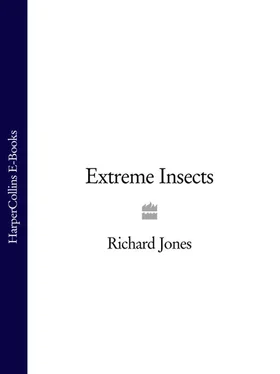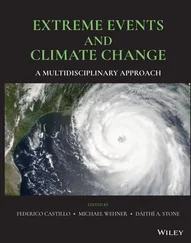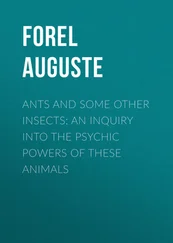Extreme Insects
Richard Jones

This book is for my parents. My father, Alfred Jones,
from whom I acquired my love of natural history, gave
me a precious gift – the thirst for knowledge. My
mother, Rosamond Jones, gave me the time and her
tolerance, whilst I tried to quench it.
Introduction
Extreme From
Oldest insect
Biggest insect
Longest insect
Whitest insect
Shiniest insect
Slimiest insect
Biggest blockhead
Most sexually dimorphic insect
Most mixed-up sexuality
Most bloated insect
Most seasonally dimorphic insect
Highest number of wings
Flattest insect
Most back-to-front insect
Longest ovipositor
Widest head
Brightest light generation
Most variable colour pattern
Bloodiest insect
Most beautiful insect
Longest head
Most streamlined insect
Loudest insect
Best hoverer
Ugliest insect
Largest jaws
Largest wingspan
Best camouflage
Most transparent wings
Hairiest legs
Snappiest jaws
Prettiest eyes
Most elegant eggs
Largest eye markings
Lightest footstep
Furriest insect
Most poisonous insect
Most heavily armoured insect
Longest wing tails
Best burrower
Smallest insect
Heaviest insect
Fastest flier
Fastest runner
Longest tongue
Smelliest insect
Most subterranean insect
Fastest wing-beat
Smallest egg
Largest egg
Spikiest insect
Biggest feet
Largest claws
Extreme Evolution
Most punctual insect
Giddiest insect
Most useful young
Best mutual coexistence
Largest overwintering congregation
Largest colony
Most generous nuptial gift
Best passenger
Most necrophilic insect
Cleverest digger
Most violent sex act
Biggest plant distortion
Best thermometer
Best architect
Cleverest drinker
Most dangerous egg-laying strategy
Most adventurous insect
Most disgusting habits
Most cold-tolerant insect
Most devious prey trap
Most untrusting sex act
Best sculptor
Most unusual foodstuff
Most extreme metamorphosis
Best eyesight
Best mimic
Biggest migration
Best wrestler
Largest swarm
Longest-lived adult
Shortest larval stage
Best kicker
Most organised society
Most unsavoury defecation behaviour
Shortest-lived adult
Most explosive insect
Longest sperm
Largest parasite
Highest heat tolerance
Most diverse life histories
Most bizarre reverse metamorphosis
Longest larval stage
Best jumper
Best dancer
Best thief
Most patient insect
Best sunbathing protection
Most widespread insect
Extreme Impact
Most useful scientific research tool
Most painful sting
Most revered insect
Most boring insect
Most eaten by humans
Most (un)wanted
Best human aphrodisiac
Most confusing insect
Most sinister insect
Most misplaced insect
Oldest surviving insect specimen
Most bewitching insect
Most important averted plague
Most unusually represented in art
Most musical insect
Most helpful clean-up
Worst plague
Most unusual mode of range extension
Most embarrassing insect
Most dangerous insect
Most valuable service
Most diverse insect fauna
Most irritating insect
Most valuable insect product
Most medically useful insect
Most dermatologically useful insect
Most dramatic recovery from near-extinction
Most forensic insect
Worst infestation of a person
Best example of evolution in action
Most endangered species
Most destructive insect
Most diverse group
Rarest insect
Index
Stop Press
Acknowledgements
Copyright
About the Publisher
Insects are the most extreme organisms on Earth, and despite their diminutive stature, they wield inordinate power. With the exception of the polar ice caps, every terrestrial ecosystem on Earth is colonised by insects and to some extent controlled by them (and they have made inroads onto the open ocean, too). They dominate the middle ground of virtually every terrestrial food chain or food web.
Insects are extreme in numbers. A single leaf-cutter ant nest, the size of a large camper van buried in the soil, may contain 8 million individuals working together as a single giant super-organism. In the tropical rainforests, termites can reach densities of 10,000 per square metre, a higher density of animal mass than in the largest wildebeest herds of the Serengeti. To produce such numbers, insects are extreme in their fecundity. Egg loads can be counted in thousands and generation times in days. If conditions are right, plagues of biblical proportions can appear as if spontaneously.
Insects are extreme in diversity. Even the experts cannot agree whether there are 3 million different species of insect on the Earth, 10 million, 30 million or 80 million. Compare that to the mere 5,400 known species of mammal. About four-fifths of all the animals yet discovered on our planet are insects: that’s over 1 million species at the last count. And there are many times that number out there awaiting discovery.
Insects are extreme in form. Evolved into the most peculiar shapes and colours, with strange structures and beautiful patterns, even the smallest of these wonderful creatures is magnificent under the microscope. Each has adapted to solve the extreme pressures that arise in the struggle to survive in a world that is dangerous, competitive and unforgiving.
Extreme Insects is divided into three chapters, exploring the nature of the insect universe and looking at some of the most extraordinary creatures in existence.
Extreme Form. In addition to the biggest, smallest, and largest wingspan, we take a look at extreme shapes: spikiest, furriest, shiniest, flattest. Why have such forms evolved? What benefit do they give to the insects that possess them?
Extreme Evolution. Some parts of insect anatomy can appear completely alien to the human eye. They have evolved to allow their possessors a special tool, weapon or means of escape. They have allowed certain insects to survive in extremely difficult or dangerous circumstances. Insects are complex creatures that interact with each other, with their food and with enemies who see them as food. And they get up to some very strange things. They seem to be dancing, skulking or hiding. They brave danger or run like cowards. Some nurture and some murder; some commit suicide. They may appear very clever or extremely dim. Some steal and some give gifts. What is the biological explanation behind these apparently odd behaviours?
Extreme Impact. Humans now reckon themselves to be the dominant life form on Earth, but we have been around for only a few hundred thousand years. Insects were here over 300 million years earlier. Humans, the mere junior upstarts, now come into conflict with a much older and better-established group of organisms. And despite our modern sophistication, we cannot escape such tenacious and apparently determined animals. They invade our fields, our houses and even our bodies. Some we can tame for our own uses, but with others we are still at war.
Читать дальше













